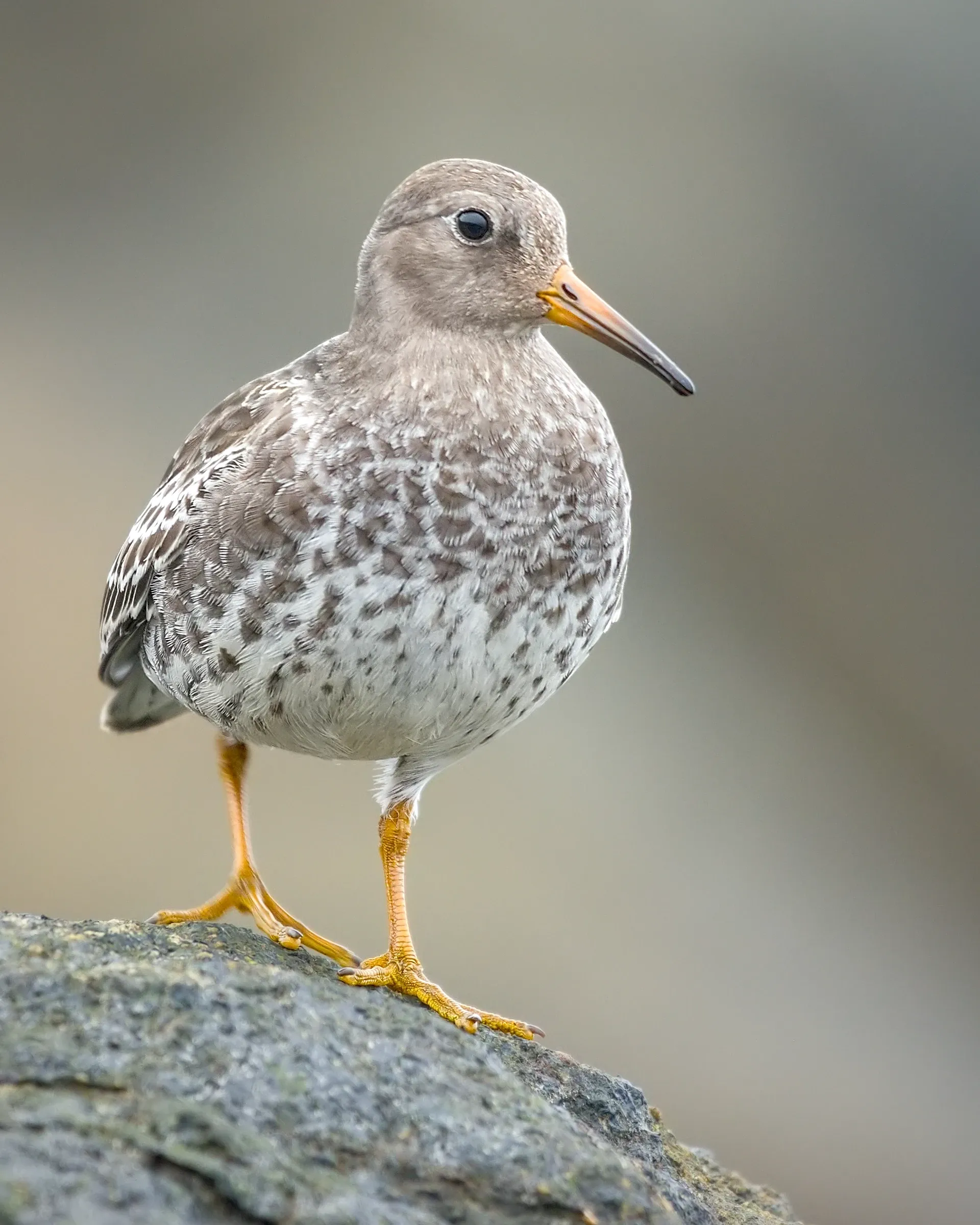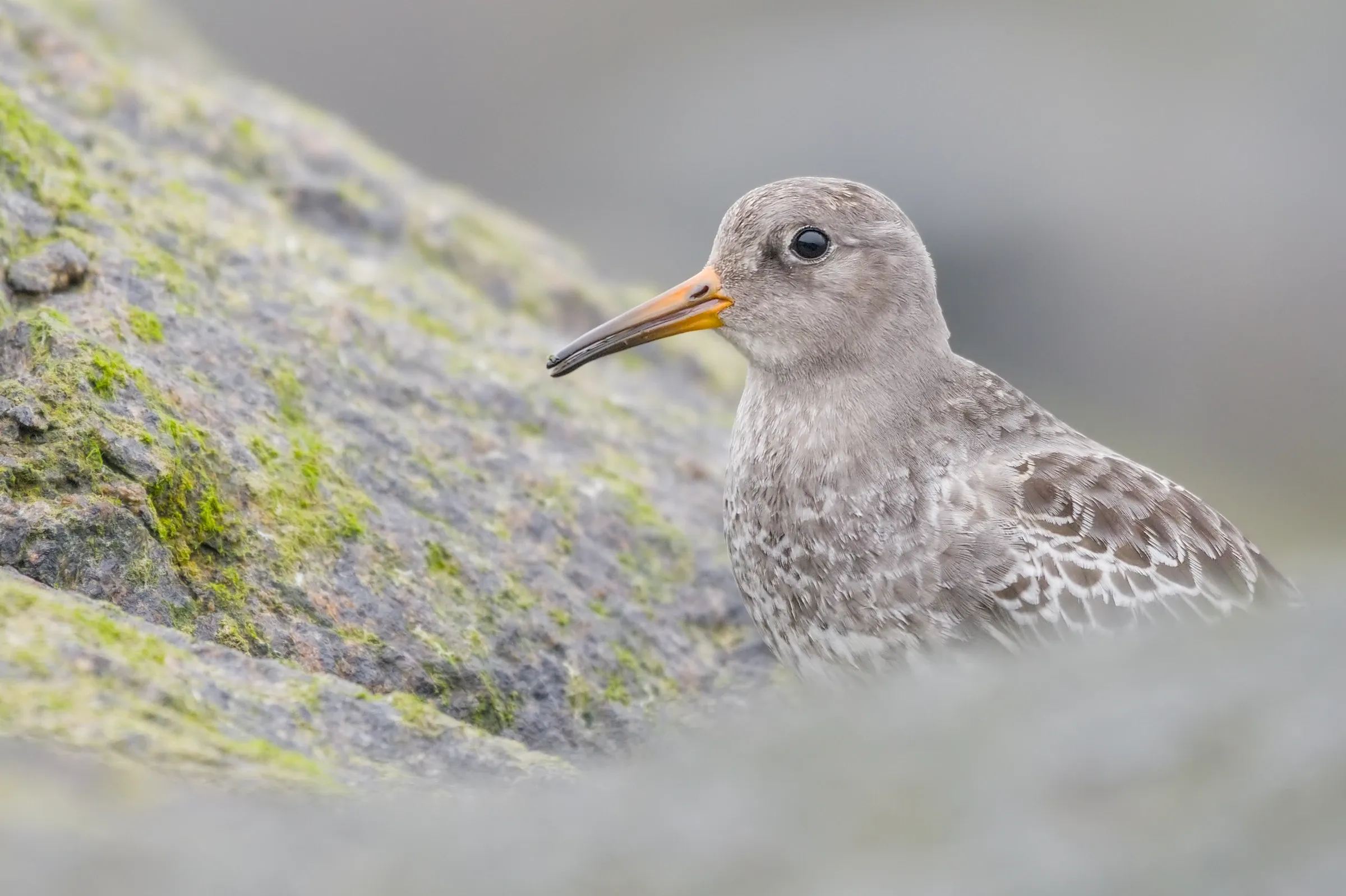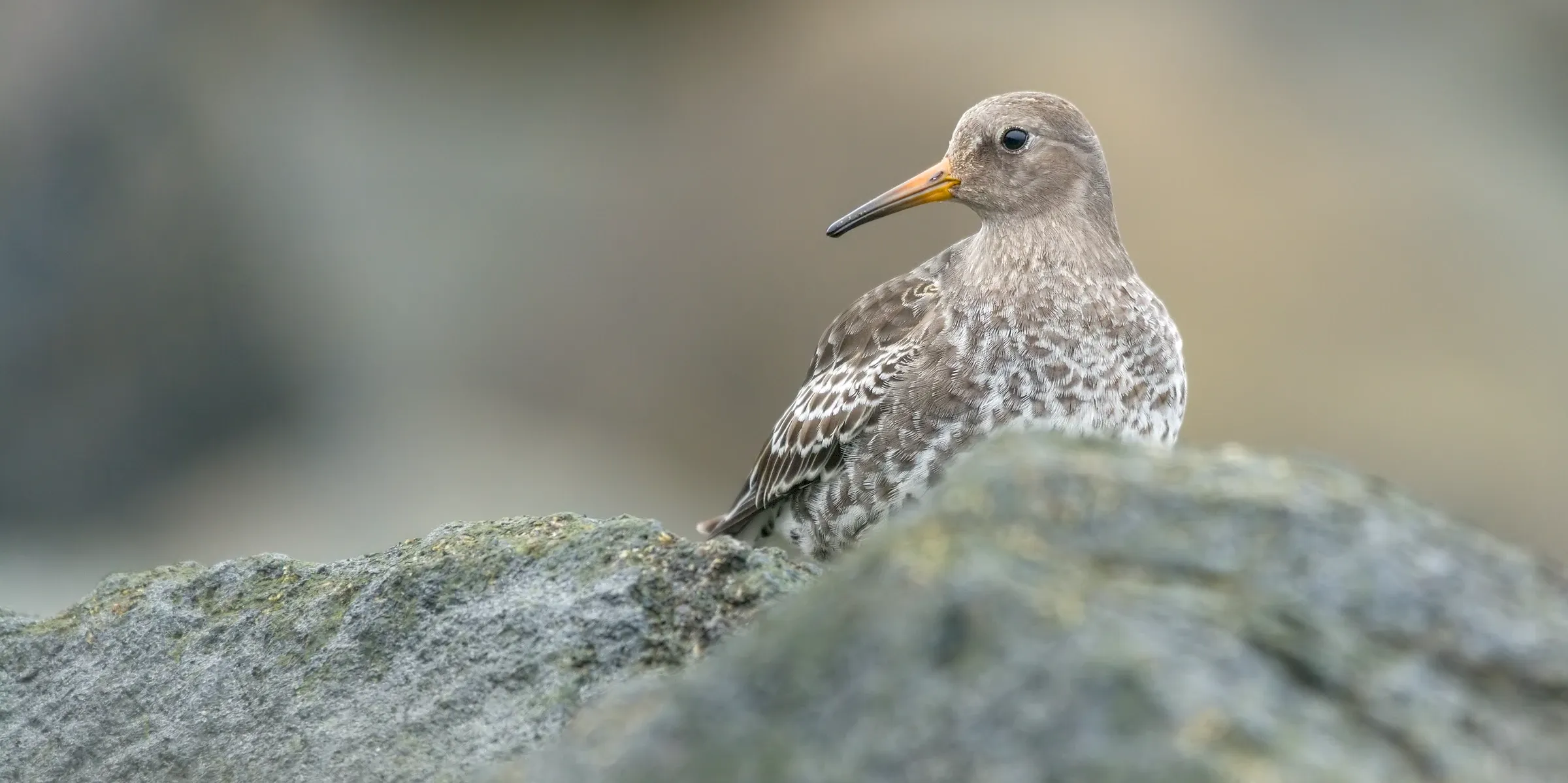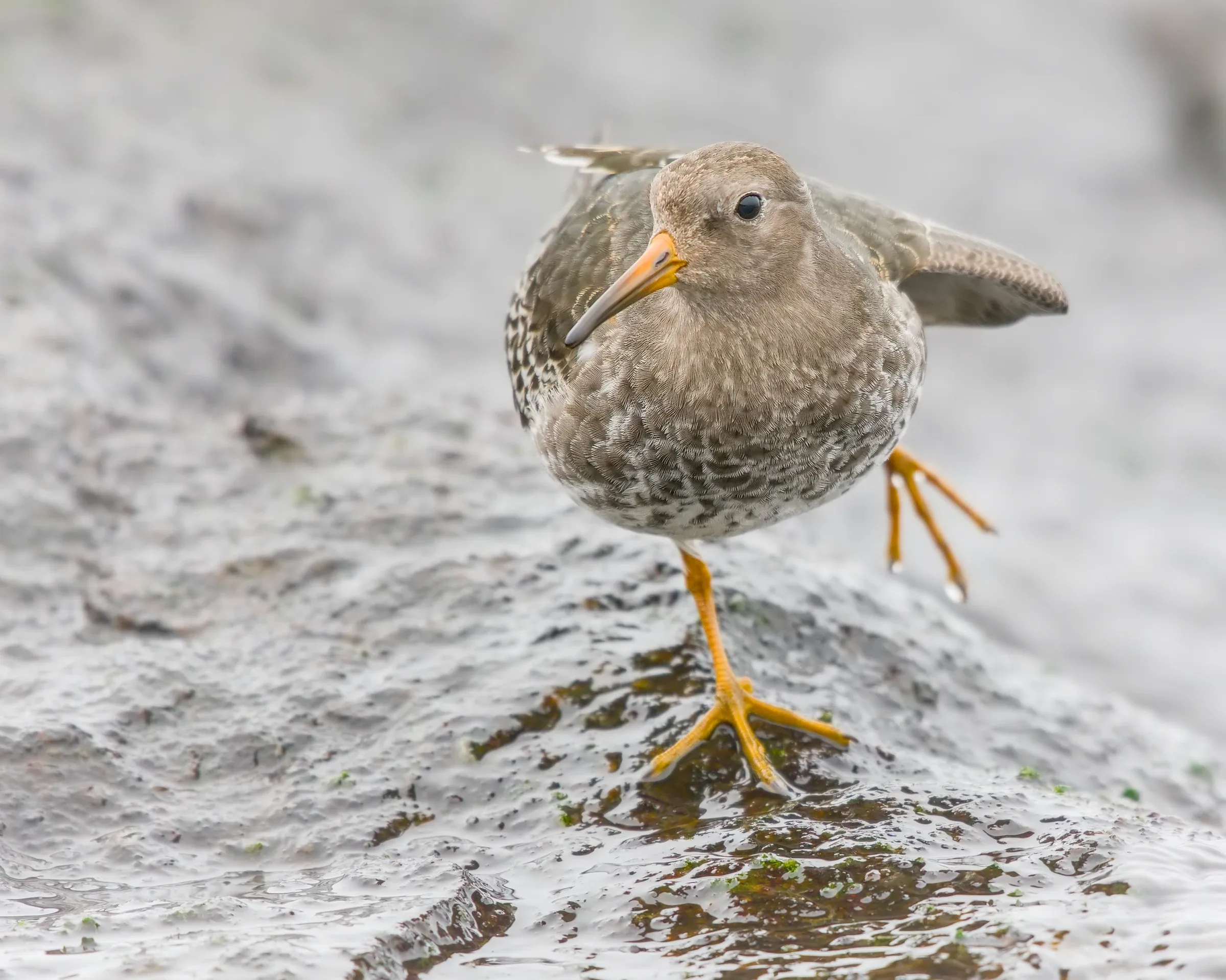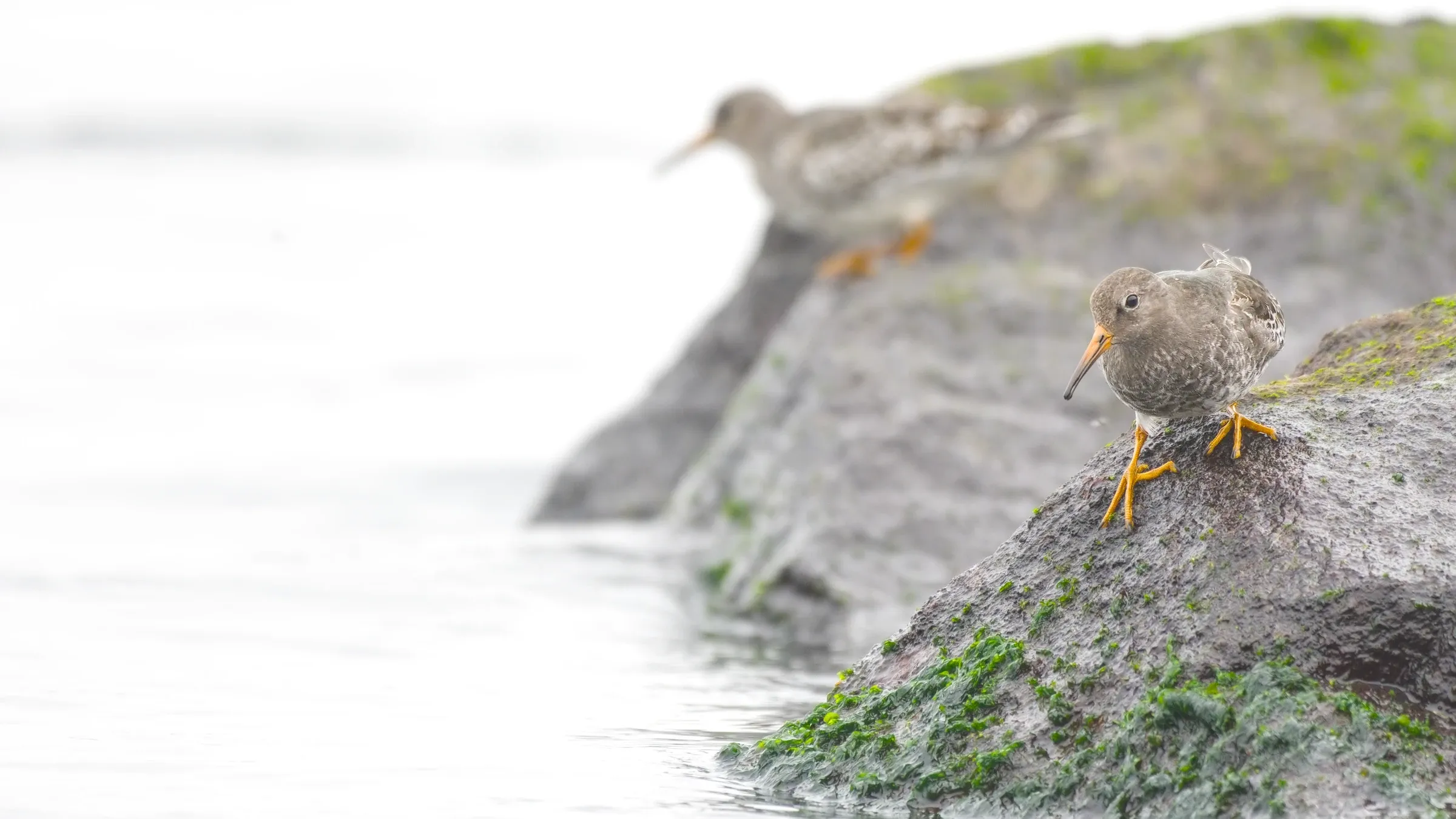Warnemünde isn’t my usual spot for photography. It’s too touristy, crowded, and noisy—peace is hard to come by here. But once a year, Warnemünde turns into something truly special, and no, I’m not talking about the Hanse Sail. Each autumn and winter, a small group of Purple sandpipers makes an appearance. These hardy little creatures scour the harbour’s breakwaters in search of food.
During the winter, it’s worth keeping an eye on the online platform Ornitho.de. Bird sightings from all over Germany are recorded there, making it a valuable tool to track when the Purple sandpipers (Calidris maritima) arrive in Warnemünde. These waders are well worth a visit, as they are incredibly rare in Germany. According to NABU, they’re so scarce that any sightings should be reported to the local avifaunal commission to support scientific monitoring of this exceptional species.

Purple sandpipers nest far up in the north, in rocky tundra landscapes like those in Scandinavia and Iceland. Some individuals remain in the tundra throughout the winter, while others spend the season along rocky coastal stretches in their wintering grounds.
When the Purple sandpipers arrive in Warnemünde, the search begins. Warnemünde has three harbour breakwaters: the Westmole, Mittelmole, and Ostmole. The Westmole and Mittelmole are located west of the harbour, in Warnemünde’s main area. The Ostmole, on the other hand, is accessible by ferry. Since the Purple sandpipers like to frequent all three breakwaters, spotting them often involves a bit of a treasure hunt. A pair of binoculars can be a big help!
My search began at the Westmole, continued to the Mittelmole, and ended with a five-minute ferry ride to the Ostmole. Compared to summer, Warnemünde is wonderfully quiet in winter, making my ‘stroll’ along the fresh Baltic Sea air all the more enjoyable. Along the way, I watched various gulls—black-headed, common, herring, and great black-backed gulls—and even witnessed a great black-backed gull snatch a sizeable fish from a cormorant. From the harbour ferry’s western dock, I caught sight of a kingfisher darting across the harbour basin.
Photographing Up Close
Arriving at the tip of the Ostmole, I found three Purple sandpipers busily foraging among the rocks, sticking close to the waterline. These three became my subjects for the next few hours, scurrying over the stones with endless energy. I climbed down the rocks to get on eye level with them. The little birds were completely unfazed by my presence, often coming within arm’s reach. This gave me countless opportunities for close-up portraits.
Even though my three little buddies couldn’t have been more coöperative, the final image in the portrait gallery hints at just how tricky this shoot was. A thick layer of clouds meant there was very little light to work with. To properly expose the photos, I had to use relatively slow shutter speeds—often shooting at 1/100 second. However, Purple sandpipers are incredibly lively and almost never stand still. The combination of their constant movement and the slower shutter speed resulted in many blurry shots. While modern cameras can compensate for low light with high ISO settings, my Nikon D7100 struggles; anything above ISO 2000 makes the photos practically unusable.

The shooting conditions presented yet another challenge: focusing. Since the Purple sandpipers blend in almost perfectly with the colour of the mole’s rocks, my ›blind‹ camera often locked onto the high-contrast wing patterns instead of the birds’ faces.
Approachable little birds on one side, tricky lighting conditions on the other. In bird photography, shooting situations are often beyond our control. For me, that’s exactly what makes it so captivating. So, I devised a plan for the shoot, aiming to capture a variety of images despite the challenges.
Why the Background Matters
The background occupies a large portion of many bird photos. When the sky is overcast, water in the background creates a monotonous greyish surface behind the subject, as it reflects the colour of the sky. I find these backgrounds uninspiring. For me, engaging with the bird world also means engaging with the diverse habitats of birds. In my view, backgrounds are an excellent way to portray or hint at these habitats. A dull grey backdrop, therefore, is a missed opportunity.
Instead of water in the background, I tried capturing the Purple sandpipers against the dark rocks of the mole. The stones can also be incorporated into the foreground, emphasising the habitat of the »mole« and adding multiple ›layers‹ to the image.
I repeatedly noticed that the Purple sandpipers didn’t shy away from the cold water. Once, one of the birds slipped and fell into the water. Another time, a wave crashed over one of the little creatures. I would have loved to capture such a scene, but to freeze the splashing water, I would have needed more light. I didn’t want to use motion blur or panning techniques, as this more painterly style of photography doesn’t really align with my own approach. You can find such impressionistic images, for instance, in the work of Rostock photographer Kai Bratke.
Action shots give the subject personality
While the background influences the mood of the photo, action shots offer a deeper glimpse into the birds‹ ›everyday life.‹ With the camera, it’s even possible to reveal what would otherwise remain unseen by the naked eye. I managed to capture a few shots of a Purple sandpiper feeding. In the following series of images, I believe I can make out our feathered friend either pulling a small worm from the rocks or fishing it out of the water.
With a bit of patience, it’s often possible to observe birds engaging in ‘self-care.’ They pluck damaged feathers from their plumage, shake themselves dry or to rearrange their feathers, and even do ‘bird yoga.’ I always feel honoured when birds indulge in their grooming routines in front of me, as it’s a sign that they feel comfortable and safe.
A basic understanding of bird body language is useful both for birdwatching and bird photography. Birds give us signals about whether they feel comfortable or if we’ve gotten too close. Subtle movements can hint that a bird is about to take flight or that two birds are about to mate. Those who pick up on these cues have a good chance of witnessing rare behaviours and, perhaps, even capturing them on camera.

With a glance upward, the Purple sandpiper scans the sky for birds of prey. Sea eagles are not uncommon on the Baltic Sea, but even a small sparrowhawk can pose a threat to a Purple sandpiper.
Small details can be fascinating
The fine details in a bird’s plumage are not visible to the naked eye. Even with a telephoto lens, the distance to the bird is often too great to capture these nuances. Detail shots are therefore not only relatively rare, but also a testament to a special intimacy. The photographer and the subject must have been very close. For this reason, detail shots seemed like the perfect way to convey the closeness that the three protagonists allowed. Additionally, detail photos often reveal aesthetically captivating patterns and colours..

The three reddish-edged feathers to the left of the centre come from the breeding plumage that Purple sandpipers wear in summer. In Germany, we don’t get to see Purple sandpipers in their full breeding plumage.
What particularly fascinated me were the bright orange feet of the Purple sandpipers, which they use to navigate confidently over the slippery rocks. These feet are tricky to photograph, as they rarely stay still. But tricky doesn’t mean impossible.

In November, the Baltic Sea is icy cold. If I were to walk barefoot over the breakwaters, my feet would freeze. But the Purple sandpipers aren’t bothered by the chilly water at all.
Just zoom out: Magnification and Depth of Field
Most of the time, I use my lens at its maximum focal length, meaning I zoom in as much as possible. I simply love when the bird appears as large as possible, and the background dissolves into a blur. However, once I had the desired shots in the bag—portraits, action shots, and details—I decided to take a few shots with less zoom. These allowed me to incorporate more of the habitat into the frame. Additionally, I managed to capture a few images featuring not just one, but two Purple sandpipers.
If I ever find the time to visit the Purple sandpipers again, I would choose a clear-sky evening. In winter, the setting sun bathes the Baltic Sea at Warnemünde in vibrant colours. I can imagine that the Purple sandpipers would make a fascinating subject in such a backlighting situation.
Conclusion
The shoot with the three Purple sandpipers in Warnemünde was a great experience. The fact that the three waders approached me completely unbothered, coming as close as an arm’s length, created an interesting contrast with the overcast lighting and the weak contrasts between the subject and the background in the mole setting. Although I took many unusable shots that day, I managed to capture a few photos that I’m really pleased with. I’m especially happy with the portrait shots and the detail photos.










